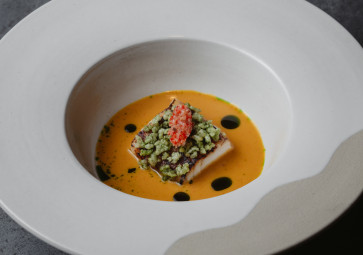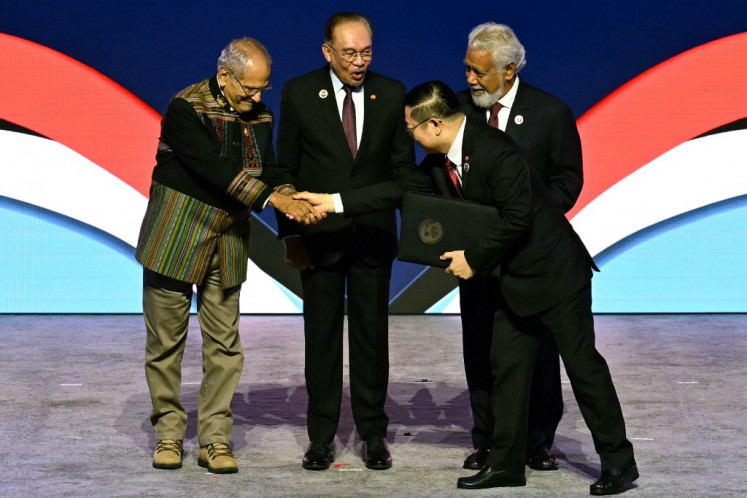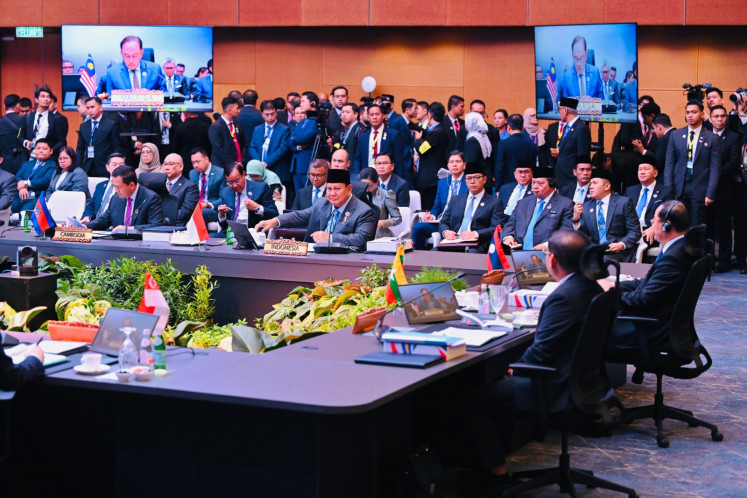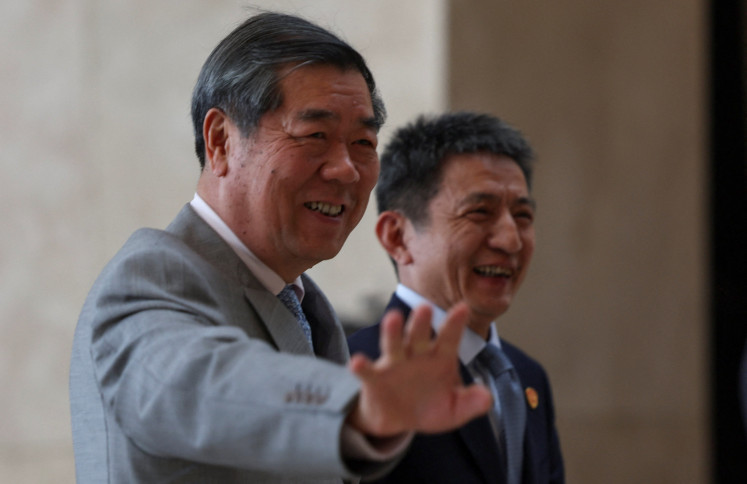Popular Reads
Top Results
Can't find what you're looking for?
View all search resultsPopular Reads
Top Results
Can't find what you're looking for?
View all search resultsDa Vinci, Renaissance: The Italian touch to the art of costume
Sculptures: The costumes will be on display at the Italian Cultural Institute in Jakarta until Feb
Change text size
Gift Premium Articles
to Anyone
Sculptures: The costumes will be on display at the Italian Cultural Institute in Jakarta until Feb. 22. (JP/Isabelle Harris)
The ongoing Leonardo Opera Omnia exhibition not only features high-definition reproductions of Leonardo da Vinci’s celebrated masterpieces in their original scales but also 13 Renaissance costumes — paraded around and plunging everyone into a world of duchesse fabric and paintings from the Mona Lisa to The Last Supper.
The costumes from Il Costume Atelier are being exhibited at the Italian Cultural Institute in Menteng, Central Jakarta, until Feb. 22, in conjunction with the Leonardo Opera Omnia exhibition, held to mark the 500th anniversary of da Vinci’s passing at the Bank Mandiri Museum in Central Jakarta from Feb. 6 to March 3.
The idea to include the costume exhibition — jointly organized by the Italian Embassy, Istituto di Moda Burgo Indonesia and Il Teatro della Moda Indonesia — came from Maria Battaglia, director of the Italian Cultural Institute in Jakarta.
“[Leonardo da Vinci] was very interested in fashion as well,” she said when describing why a fashion show of these costumes was included.
Up close: A model wears an elaborate headdress during the show at the Leonardo Opera Omnia exhibition opening. (Courtesy of Italian Cultural Institute)
Launched in February last year, the Leonardo Opera Omnia exhibition has been held in several places in other Asian countries, including China, Malaysia and Myanmar.
Throughout this year, both the Italian Embassy in Jakarta and the Italian Cultural Institute will hold a series of events related to the European Renaissance that started in the 14th century in Florence, Italy — a period when society became fascinated with classical philosophy and literature and intellectualism was highly prized. It also brought about huge interest and progress in art, exploration and technology that laid the foundation for the modern age.
Artists such as Leonardo da Vinci, Michelangelo, Donatello and Raphael alongside many others created iconic artworks during this period.
In Italian, the word rinascimento means rebirth, Battaglia said. “The renaissance was a revolution of culture.”
Into detail: A model showcases a costume that used to be worn only by the nobility. (Courtesy of Italian Cultural Institute)
The era also brought about a stark change in fashions for men and women. Long skirts and sleeves with beaded hairnets were common for women, while men wore belted tunics and hose or stockings. All required vast amounts of expensive and difficult to make fabrics such as duchesse and silks that were dyed and embroidered. Extravagant clothes like these were worn by renaissance nobility as a status symbol.
Running her hands along the sleeves of a red taffeta dress, Battaglia said back then, these dresses would only be worn by rich or noble women in Italian high society. “It’s a symbol of status,” she said.
The Fashion Institute of Technology at the State University of New York says that historically, upper classes set the fashions, relying on multiple artisans to create each look. Today, accurate reproductions such as these are created by talented artisans, Battaglia said.
“These dresses are made by an Italian dressmaker, an atelier [Il Costume Atelier]” she added.
Each of the 13 costumes were made by hand by an Italian artisan, from the heavily detailed and historically accurate under dresses to the long and cumbersome sleeveless long coats. Many feature fine embroidery and small embossed metal trimmings. “They have this touch, you see? The Italian touch,” Battaglia said, holding out an embroidered sleeve.
Giulio Gessner, a former worker at a tie fabric making business who attended the exhibition, said that an incredible amount of artistry went into the fabrics that made up recreation costumes such as those on display. “There is some tradition to making these kinds of dresses,” he said.
Fabrics embroidered with intricate patterns, like the ones found on the front panels and puffed sleeves of the costumes, require the use of complicated machines with many threads and can be difficult to make. The companies that make fabrics for these costumes do so “not without help” he said. “They have designs, paintings from the old times and they collect the information from there,” he said, referring to the laser accuracy of some of the costumes.
“To me, fashion is [like] designing art pieces,” Battaglia said. “These things are handmade with attention and precision.”
— Isabelle traveled to Jakarta with the assistance of the ACICIS Consortium for Indonesian Studies.

![Sculptures: The costumes will be on display at the Italian Cultural Institute in Jakarta until Feb. 22. (JP/Isabelle Harris)" width="780" height="695" border="0">Sculptures: The costumes will be on display at the Italian Cultural Institute in Jakarta until Feb. 22. (JP/Isabelle Harris)</p><p>The ongoing Leonardo Opera Omnia exhibition not only features high-definition reproductions of Leonardo da Vinci’s celebrated masterpieces in their original scales but also 13 Renaissance costumes — paraded around and plunging everyone into a world of duchesse fabric and paintings from the <em>Mona Lisa</em> to <em>The Last Supper</em>.</p><p>The costumes from Il Costume Atelier are being exhibited at the Italian Cultural Institute in Menteng, Central Jakarta, until Feb. 22, in conjunction with the Leonardo Opera Omnia exhibition, held to mark the 500th anniversary of da Vinci’s passing at the Bank Mandiri Museum in Central Jakarta from Feb. 6 to March 3.</p><p>The idea to include the costume exhibition — jointly organized by the Italian Embassy, Istituto di Moda Burgo Indonesia and Il Teatro della Moda Indonesia — came from Maria Battaglia, director of the Italian Cultural Institute in Jakarta.</p><p>“[Leonardo da Vinci] was very interested in fashion as well,” she said when describing why a fashion show of these costumes was included.</p><p><img src="http://202.158.21.182/files/images2/p16-photo-C.MASKING-PLEASE.jpg" alt="Up close: A model wears an elaborate headdress during the show at the Leonardo Opera Omnia exhibition opening. (Courtesy of Italian Cultural Institute)" title="Up close: A model wears an elaborate headdress during the show at the Leonardo Opera Omnia exhibition opening. (Courtesy of Italian Cultural Institute)](https://www.thejakartapost.com/files/images2/p16-E_0.img_assist_custom-780x697.jpg)











